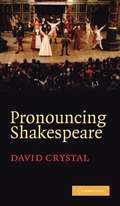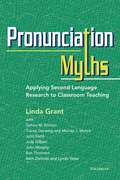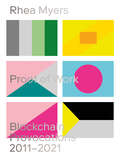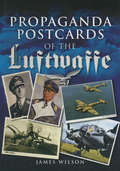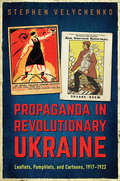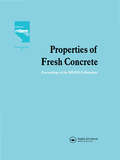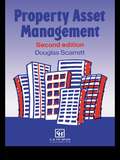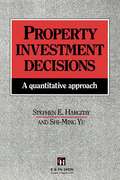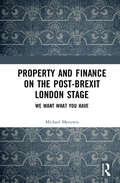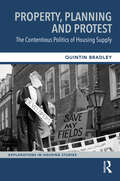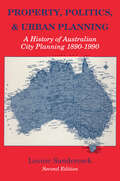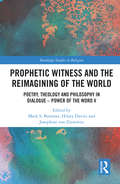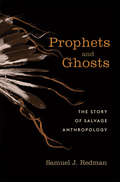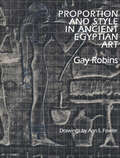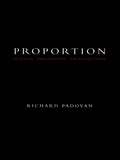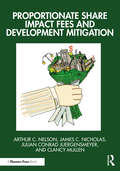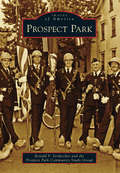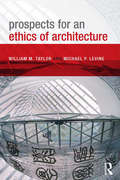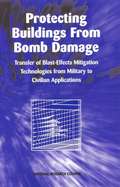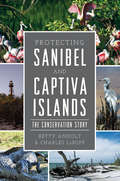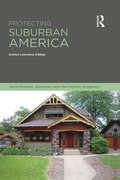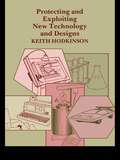- Table View
- List View
Pronouncing Shakespeare: The Globe Experiment
by David CrystalIn an unusual blend of autobiography, narrative, and academic content, reflecting the unique nature of the experience, David Crystal recounts the first attempt in over 50 years to mount a full-length Shakespeare play in original pronunciation.
Pronunciation Myths: Applying Second Language Research to Classroom Teaching
by Linda GrantThis volume was conceived as a "best practices" resource for pronunciation and speaking teachers in the way that Vocabulary Myths by Keith S. Folse is one for reading and vocabulary teachers. Like others in the Myths series, this book combines research with good pedagogical practices. The book opens with a Prologue by Linda Grant (author of the Well Said textbook series), which reviews the last four decades of pronunciation teaching, the differences between accent and intelligibility, the rudiments of the English sound system, and other factors related to the ways that pronunciation is learned and taught. The myths challenged in this book are: § Once you've been speaking a second language for years, it's too late to change your pronunciation. (Derwing and Munro) § Pronunciation instruction is not appropriate for beginning-level learners. (Zielinski and Yates) § Pronunciation teaching has to establish in the minds of language learners a set of distinct consonant and vowel sounds. (Field) § Intonation is hard to teach. (Gilbert) § Students would make better progress if they just practiced more. (Grant) § Accent reduction and pronunciation instruction are the same thing. (Thomson) § Teacher training programs provide adequate preparation in how to teach pronunciation (Murphy). The book concludes with an Epilogue by Donna M. Brinton, who synthesizes some of the best practices explored in the volume.
Proof of Work: Blockchain Provocations 20112021 (Urbanomic / Art Editions)
by Rhea MyersA beautifully produced anthology of crypto-artist, writer, and hacker Rhea Myers's pioneering blockchain art, along with a selection of her essays, reviews, and fictions.DAO? BTC? NFT? ETH? ART? WTF? HODL as OG crypto-artist, writer, and hacker Rhea Myers searches for faces in cryptographic hashes, follows a day in the life of a young shibe in the year 2032, and patiently explains why all art should be destructively uploaded to the blockchain. Now an acknowledged pioneer whose work has graced the auction room at Sotheby&’s, Myers embarked on her first art projects focusing on blockchain tech in 2011, making her one of the first artists to engage in creative, speculative, and conceptual engagements with "the new internet." Proof of Work brings together annotated presentations of Myers&’s blockchain artworks along with her essays, reviews, and fictions—a sustained critical encounter between the cultures and histories of the artworld and crypto-utopianism, technically accomplished but always generously demystifying and often mischievous. Her deep understanding of the technical history and debates around blockchain technology is complemented by a broader sense of the crypto movement and the artistic and political sensibilities that accompanied its ascendancy. Remodeling the tropes of conceptual art and net.art to explore what blockchain technology reveals about our concepts of value, culture, and currency, Myers&’s work has become required viewing for anyone interested in the future of art, consensus, law, and collectivity.
Propaganda Postcards of the Luftwaffe
by James WilsonPropaganda Postcards of the Luftwaffe focuses on the efforts of the powerful Nazi propaganda machine to promote the technical achievements and might of the then newly created German airforce. The Luftwaffe had been announced to the world in March 1935, despite the restrictions contained in the Versailles Treaty signed after the First World War denying Germany the right to develop military aircraft. All major aircraft types used by the Luftwaffe together with many lesser known, obscure and secondary types are represented in this book. There is a section covering the main figures of the Luftwaffe and the leading aces who flew the aircraft. The German Air and Propaganda ministries worked together and, using professional photographers produced quality images, which were then made available to the general public in an attempt to inspire the nation and create strong moral.
Propaganda in Revolutionary Ukraine: Leaflets, Pamphlets, and Cartoons, 1917–1922
by Stephen VelychenkoPropaganda in Revolutionary Ukraine is a survey of domestic government and party printed propaganda in revolutionary Ukraine. It is the first account in English to study these materials using an illustrative sample of printed texts and to assess their impact based on secret police and agitator situation reports. The book surveys texts published by the Central Rada, the Ukrainian State, the Ukrainian National Republic, the Ukrainian Socialist Revolutionary Party, the Ukrainian Social Democratic and Labour Party, the Independentists, Ukrainian Communist Party (UCP), Ukraine’s Bolshevik Party (CPU), and anti-Bolshevik warlords. It includes 46 reproductions and describes the infrastructure that underlay the production and dissemination of printed text propaganda. The author argues that in the war of words neither Ukrainian failures nor Bolshevik success should be exaggerated. Each side managed to sway opinion in its favour in specific places at specific times.
Properties of Fresh Concrete: Proceedings of the International RILEM Colloquium
by H. J. WierigThis book presents new information on concrete properties and production in the light of the widespread use of ready mixed concrete and new concreting materials. This book forms the Proceedings of the RILEM Colloquium held in Hanover, West Germany in October 1990. Papers from 18 countries in Europe, North America and the Far East are included.
Property Asset Management
by D. ScarrettProperty has unique characteristics, both as an investment and as an operational holding. A thorough understanding of this dual role is needed by professionals responsible for maximising a property's full potential. Property Asset Management emphasizes the need for a strategic plan in property management as well as for efficient day-to-day practice.
Property Investment Decisions: A quantitative approach
by S. Hargitay S Hargitay S-M YuThe importance of property as an investment medium continues to grow. Investors in property or those involved with the provision of expert advice to investors have had to improve the effectiveness and efficiency of their decision making. The aim of this book is to lay down the theoretical foundations of investment decision making, incorporating the techniques and procedures of modern management science, so that particular decisions regarding property investment can be made efficiently and rationally.
Property and Finance on the Post-Brexit London Stage: We Want What You Have
by Michael MeeuwisA guide to the contemporary London stage as well as an argument about its future, the book walks readers through the city’s performance spaces following the Brexit vote. Austerity-era London theatre is suffused with the belief that private ownership defines full citizenship, its perspective narrowing to what an affluent audience might find relatable. From pub theatres to the National, Michael Meeuwis reveals how what gets put on in London interacts with the daily life of the neighbourhoods in which they are set. This study addresses global theatregoers, as well as students and scholars across theatre and performance studies—particularly those interested in UK culture after Brexit, urban geography, class, and theatrical economics.
Property, Planning and Protest: The Contentious Politics of Housing Supply (Explorations in Housing Studies)
by Quintin BradleyThe struggle for the right to housing is a battle over property rights and land use. For housing to be provided as a human need, land must be recognised as a common right. Property, Planning and Protest is a compelling new investigation into public opposition to housing and real estate development. Its innovative materialist approach is grounded in the political economy of land value, and it recognises the conflict between communities and real estate capital as a struggle over land and property rights. Property, Planning and Protest is about a social movement struggling for democratic representation in land-use decisions. The amenity groups it describes champion a democratic plan-led system that allocates land for social and environmental goals. Situating this movement in a history of land reform and common rights, this book sets out a persuasive new vision of democratic planning and affordable housing for all.
Property, Politics, and Urban Planning: A History of Australian City Planning 1890-1990
by Leonie SandercockThis text on the origins and history of city planning in Australian cities covers the emergence of the Town Planning Movement, and planning from the nineteenth century through to the post-1980s period. Looking at the cities of Adelaide, Melbourne and Sydney.
Prophetic Witness and the Reimagining of the World: Poetry, Theology and Philosophy in Dialogue- Power of the Word V (Routledge Studies in Religion)
by Mark S. Burrows Hilary Davies Josephine Von ZitzewitzThis book explores the prophetic characteristics of literature, particularly poetry, that seek to reimagine the world in which it is written. Using theological and philosophical insights it charts the relentless impulse of literature to propose alternative visions, practicable or utopian, and point toward possibilities of renewal and change. Drawing from each of the three main Abrahamic religions, as well as Greek and Latin classics, an international group of scholars utilise a diverse range of analytical and interpretive methods to draw out the prophetic voice in poetry. Looking at the writings of figures like T. S. Elliot, Blake, Wittgenstein and Isaiah, the theme of the prophetic is shown to be of timely importance given the current state of geo-political challenges and uncertainties and offers a much-needed critical discussion of these broad cultural questions. This collection of essays offers readers an insight into the constructive power of literature. As such, it will be of great interest to scholars working in Religion and the Arts, Religious Studies, Theology and Aesthetics.
Prophets and Ghosts: The Story of Salvage Anthropology
by Samuel J. RedmanA searching account of nineteenth-century salvage anthropology, an effort to preserve the culture of “vanishing” Indigenous peoples through dispossession of the very communities it was meant to protect. In the late nineteenth century, anthropologists, linguists, archaeologists, and other chroniclers began amassing Indigenous cultural objects—crafts, clothing, images, song recordings—by the millions. Convinced that Indigenous peoples were doomed to disappear, collectors donated these objects to museums and universities that would preserve and exhibit them. Samuel Redman dives into the archive to understand what the collectors deemed the tradition of the “vanishing Indian” and what we can learn from the complex legacy of salvage anthropology. The salvage catalog betrays a vision of Native cultures clouded by racist assumptions—a vision that had lasting consequences. The collecting practice became an engine of the American museum and significantly shaped public education and preservation, as well as popular ideas about Indigenous cultures. Prophets and Ghosts teases out the moral challenges inherent in the salvage project. Preservationists successfully maintained an important human inheritance, sometimes through collaboration with Indigenous people, but collectors’ methods also included outright theft. The resulting portrait of Indigenous culture reinforced the public’s confidence in the hierarchies of superiority and inferiority invented by “scientific” racism. Today the same salvaged objects are sources of invaluable knowledge for researchers and museum visitors. But the question of what should be done with such collections is nonetheless urgent. Redman interviews Indigenous artists and curators, who offer fresh perspectives on the history and impact of cultural salvage, pointing to new ideas on how we might contend with a challenging inheritance.
Proportion and Style In Ancient Egyptian Art
by Gay RobinsThe painted and relief-cut walls of ancient Egyptian tombs and temples record an amazing continuity of customs and beliefs over nearly 3,000 years. Even the artistic style of the scenes seems unchanging, but this appearance is deceptive. In this work, Gay Robins offers convincing evidence, based on a study of Egyptian usage of grid systems and proportions, that innovation and stylistic variation played a significant role in ancient Egyptian art. Robins thoroughly explores the squared grid systems used by the ancient artists to proportion standing, sitting, and kneeling human figures. This investigation yields the first chronological account of proportional variations in male and female figures from the Early Dynastic to the Ptolemaic periods. Robins discusses in detail the proportional changes underlying the revolutionary style instituted during the Amarna Period. She also considers how the grid system influenced the composition of scenes as a whole. Numerous line drawings with superimposed grids illustrate the text.
Proportion and Style in Ancient Egyptian Art
by Gay RobinsThe painted and relief-cut walls of ancient Egyptian tombs and temples record an amazing continuity of customs and beliefs over nearly 3,000 years. Even the artistic style of the scenes seems unchanging, but this appearance is deceptive. In this work, Gay Robins offers convincing evidence, based on a study of Egyptian usage of grid systems and proportions, that innovation and stylistic variation played a significant role in ancient Egyptian art. Robins thoroughly explores the squared grid systems used by the ancient artists to proportion standing, sitting, and kneeling human figures. This investigation yields the first chronological account of proportional variations in male and female figures from the Early Dynastic to the Ptolemaic periods. Robins discusses in detail the proportional changes underlying the revolutionary style instituted during the Amarna Period. She also considers how the grid system influenced the composition of scenes as a whole. Numerous line drawings with superimposed grids illustrate the text.
Proportion: Science, Philosophy, Architecture
by Richard PadovanThis handbook provides readers with a well-illustrated and readable comparative guide to proportion systems in architecture, setting out the mathematical principles that underlie the main systems and illustrating these with examples of their use in historical and modern buildings. The main body of the text traces the interplay of abstraction and empathy through the history of science, philosophy and architecture from the early Greeks through to the two early twentieth-century architects who made proportion the focus of their work: Le Corbusier and Van der Laan. The book ends with a reflection on the present and future role of proportion in architecture.
Proportionate Share Impact Fees and Development Mitigation
by Arthur C. Nelson James C. Nicholas Julian Conrad Juergensmeyer Clancy MullenAfter decades of evolving practice often tested in court, development impact fees have become institutionalized in the American planning and local government finance systems. But, they remain contentious, especially as they continue to evolve. This book is the third in a series of impact fee guidebooks for practitioners, following A Practitioner’s Guide to Development Impact Fees and Impact Fees: Proportionate Share Development Fees. Proportionate Share Impact Fees and Development Mitigation is the culmination of the authors’ careers devoted to pioneering applications of the dual rational nexus test. That test requires (1) establishing the rational nexus between the need for infrastructure, broadly defined, to mitigate the impacts of development and (2) ensuring that development mitigating its infrastructure impacts benefits proportionately. The book elevates professional practice in two ways. First, it shows how the rational nexus test can be applied to all forms of development infrastructure impact mitigation. Second, it establishes the link between professional ethics and equity as applied to proportionate share impact fees and development mitigation. The book is divided into four parts, with the first reviewing policy and legal foundations, the second detailing the planning, calculation, and implementation requirements, the third exploring economic, ethical, and equity implications, and the fourth presenting state-of-the-art case studies. Proportionate Share Impact Fees and Development Mitigation sets new standards for professional practice.
Prospect Park
by Prospect Park Community Study Group Ronald P. VerdicchioRooted in Dutch traditions, Prospect Park was established in 1901. With a view of what would become the New York City skyline, Prospect Park evolved into a community that placed an emphasis on family values and character. Children would often be seen on the streets jumping rope or playing together at the Hayfields, which later became Hofstra Park. Parents worked locally in the borough and neighboring Paterson, known as "Silk City." Families stopped by Verblaauw's Hardware for household goods and bought produce and flowers at Aiello's, which remains a vibrant business today. Though the borough has undergone an exceptional cultural transformation, Prospect Park has maintained its core values through traditions, cultural practices, and religious observances, with the Prospect Park School remaining the center of community life. New Hope Ministry and the Prospect Park Volunteer Fire Department remain essential to the life of the community. Prospect Park showcases the rich cultural, educational, and economic heritage of this northern New Jersey town.
Prospects for Pastoralism in Kazakstan and Turkmenistan: From State Farms to Private Flocks (Central Asia Research Forum)
by Carol KervenThis collection traces how pastoralists have coped with the challenges of change in a part of the world with a long-tradition of livestock keeping. Their precarious position - balanced between a market system where only the fittest may survive, and their attempt to remain a human resource for the future development of the natural pastures and livestock industry - is carefully and critically examined by the contributors. The pastoralists' unique skills at managing livestock in a variable and challenging environment, and their ability to supply commodities much in demand mean that an understanding of their societal position is essential for anyone interested in transition in the former Soviet Union.
Prospects for Resilience: Insights from New York City's Jamaica Bay
by William D. Solecki John R. Waldman Eric W. Sanderson Adam S. ParrisGiven the realities of climate change and sea-level rise, coastal cities around the world are struggling with questions of resilience. Resilience, at its core, is about desirable states of the urban social-ecological system and understanding how to sustain those states in an uncertain and tumultuous future. How do physical conditions, ecological processes, social objectives, human politics, and history shape the prospects for resilience? Most books set out "the answer." This book sets out a process of grappling with holistic resilience from multiple perspectives, drawing on the insights and experiences of more than fifty scholars and practitioners working together to make Jamaica Bay in New York City an example for the world.Prospects for Resilience establishes a framework for understanding resilience practice in urban watersheds. Using Jamaica Bay--the largest contiguous natural area in New York, home to millions of New Yorkers, and a hub of global air travel with John F. Kennedy International Airport--the authors demonstrate how various components of social-ecological systems interact, ranging from climatic factors to plant populations to human demographics. They also highlight essential tools for creating resilient watersheds, including monitoring and identifying system indicators; computer modeling; green infrastructure; and decision science methods. Finally, they look at the role and importance of a "boundary organization" like the new Science and Resilience Institute at Jamaica Bay in coordinating and facilitating resilience work, and consider significant research questions and prospects for the future of urban watersheds.Prospects for Resiliencesets forth an essential foundation of information and advice for researchers, urban planners, students and others who need to create more resilient cities that work with, not against, nature.
Prospects for an Ethics of Architecture
by Michael P. Levine William M. TaylorBringing together the reflections of an architectural theorist and a philosopher, this book encourages philosophers and architects, scholars and designers alike, to reconsider what they do as well as what they can do in the face of challenging times. It does so by exploring the notion that architecture and design can (and possibly should), in their own right, make for a distinctive form of ethical investigation. The book is less concerned with absolutist understandings of the two components of ethics, a theory of ‘the good’ and a theory of ‘the right’, than with remaining open to multiple relations between ideas about the built environment, design practices and the plurality of kinds of human subjects (inhabitants, individuals and communities) accommodated by buildings and urban spaces. The built environment contributes to the inculcation of all sorts of values (good and bad). Thus, this book aims to change the way people commonly think about ethics, not only in relation to the built environment, but to themselves, their ways of thinking and modes of behaviour.
Protecting Buildings From Bomb Damage: Transfer of Blast-Effects Mitigation Technologies from Military to Civilian Applications
by National Research CouncilThis book provides a brief overview of worldwide terrorist activity and reviews technologies and methods for designing blast resistant buildings. These techniques, primarily developed by the military, have applicability and relevance to the design of civilian structures. The volume recommends that a program of applied research and technology transfer be undertaken to hasten the availability and utility of these techniques to the civilian building community.
Protecting Sanibel and Captiva Islands: The Conservation Story (Natural History)
by Betty Anholt Charles LeBuffThe vibrant Sanibel and Captiva Islands are ecological marvels compared to Florida's many overbuilt barrier islands. Development began with the construction of the Sanibel Island Lighthouse in 1884, when only the lighthouse keeper and assistant and their families lived on the island. Noted conservationist Jay N. "Ding" Darling led the charge in preserving the islands' wildlife and natural beauty from the greed of real estate speculators and land developers in the 1930s. Former presidents like Harry Truman and cabinet-level executives worked alongside Sanibel and Captiva residents, setting up preserves and wildlife refuges to guard the integrity of the islands' unique natural blessings, abundant wildlife and aquatic stores. Charles LeBuff and Betty Anholt review the evolution of the islands' conservation ethic and how it perseveres even today.
Protecting Suburban America: Gentrification, Advocacy and the Historic Imaginary
by Denise Lawrence-ZunigaProtecting Suburban America explores the dynamics and conflicts inherent in preserving historic twentieth-century suburban landscapes in America.Bridging architecture, anthropology, planning, and urban studies, its unique approach combines a study of historic preservation with multi-sited ethnographic fieldwork, to shed fascinating light on issues of heritage, preservation, gentrification, class, ethnicity, and contested values in suburbia. These are subjects which reach far beyond the setting of the book’s focus in California to touch on topical debates in cities, suburbia, and gentrifying neighborhoods worldwide.At the heart of the book is a detailed comparative ethnography of preservation practices and the changing landscapes of five suburban cities, where affluent homeowners have begun to restore their early twentieth-century houses in neighborhoods once suffering from decline. Not every neighbor, however, shares the same aesthetic values, and complex dynamics can arise. The study compares experiences in five different cities, and in different long-term, immigrant, and gentrifying populations. Themes revealed include homeowner restoration practices, aesthetic contestations, local advocacy, and public policy, alongside an exploration of the social construction of the historic restoration process, and how homeowners construct ‘historical’ meaning in their homes and neighbourhoods. These are themes with consequences for national and global settings – of interest wherever contested preservation aesthetics and regulations are reshaping older residential neighbourhoods and their social dynamics.
Protecting and Exploiting New Technology and Designs
by K. HodkinsonThe protection of intellectual property rights has become a major concern in recent years. The opportunities being seized, or lost, in areas such as computer software or biotechnology have captured most of the headlines but in every research facility, whatever the subject, there is an increased awareness of the importance to R & D management of a more commercial attitude. Keith Hodkinson has run Government sponsored "professional updating" courses for academic and industrial researchers and business executives. The practical questions raised there and the advice found most useful have all helped to make this guide a down-to-earth source of help which will be of immediate, profitable use to its readers. Appendices to the book as well as giving lists of useful names and addresses to contact also contain examples of draft letters, contracts and record forms and licensing negotiating checklists.
